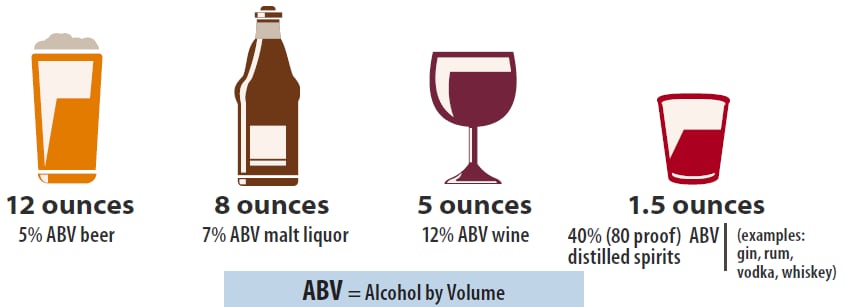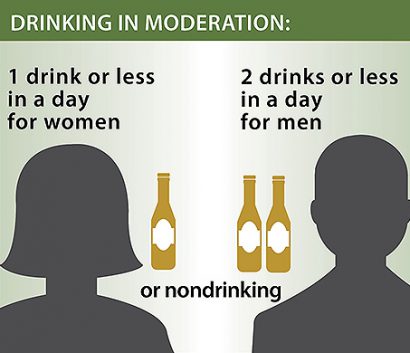Can You Put Rubdomain_7 Alcohol in Your Car
Drinking too much can harm your health. Excessive alcohol use led to approximately 95,000 deaths and 2.8 million years of potential life lost (YPLL) each year in the United States from 2011 – 2015, shortening the lives of those who died by an average of 29 years.1 Further, excessive drinking was responsible for 1 in 10 deaths among working-age adults aged 20-64 years.2 The economic costs of excessive alcohol consumption in 2010 were estimated at $249 billion, or $2.05 a drink.3
What is a standard drink?

In the United States, a standard drink contains 0.6 ounces (14.0 grams or 1.2 tablespoons) of pure alcohol. Generally, this amount of pure alcohol is found in
- 12-ounces of beer (5% alcohol content).
- 8-ounces of malt liquor (7% alcohol content).
- 5-ounces of wine (12% alcohol content).
- 1.5-ounces of 80-proof (40% alcohol content) distilled spirits or liquor (e.g., gin, rum, vodka, whiskey).4
What is excessive drinking?
Excessive drinking includes binge drinking, heavy drinking, and any drinking by pregnant women or people younger than age 21.
- Binge drinking, the most common form of excessive drinking, is defined as consuming
- For women, 4 or more drinks during a single occasion.
- For men, 5 or more drinks during a single occasion.
- Heavy drinking is defined as consuming
- For women, 8 or more drinks per week.
- For men, 15 or more drinks per week.
Most people who drink excessively are not alcoholics or alcohol dependent.5
What is moderate drinking?

The Dietary Guidelines for Americans recommends that adults of legal drinking age can choose not to drink, or to drink in moderation by limiting intake to 2 drinks or less in a day for men or 1 drink or less in a day for women, on days when alcohol is consumed.4 The Guidelines also do not recommend that individuals who do not drink alcohol start drinking for any reason and that if adults of legal drinking age choose to drink alcoholic beverages, drinking less is better for health than drinking more.4
There are some people who should not drink any alcohol, including those who are:
- Younger than age 21.
- Pregnant or may be pregnant.
- Driving, planning to drive, or participating in other activities requiring skill, coordination, and alertness.
- Taking certain prescription or over-the-counter medications that can interact with alcohol.
- Suffering from certain medical conditions.
- Recovering from alcoholism or are unable to control the amount they drink.4
By adhering to the Dietary Guidelines, you can reduce the risk of harm to yourself or others.
Short-Term Health Risks

Excessive alcohol use has immediate effects that increase the risk of many harmful health conditions. These are most often the result of binge drinking and include the following:
- Injuries, such as motor vehicle crashes, falls, drownings, and burns.6,7
- Violence, including homicide, suicide, sexual assault, and intimate partner violence.6-10
- Alcohol poisoning, a medical emergency that results from high blood alcohol levels.11
- Risky sexual behaviors, including unprotected sex or sex with multiple partners. These behaviors can result in unintended pregnancy or sexually transmitted diseases, including HIV.12,13
- Miscarriage and stillbirth or fetal alcohol spectrum disorders (FASDs) among pregnant women.6,12,14,15
Long-Term Health Risks
Over time, excessive alcohol use can lead to the development of chronic diseases and other serious problems including:
- High blood pressure, heart disease, stroke, liver disease, and digestive problems.6,16
- Cancer of the breast, mouth, throat, esophagus, voice box, liver, colon, and rectum.6,17
- Weakening of the immune system, increasing the chances of getting sick.6,16
- Learning and memory problems, including dementia and poor school performance.6,18
- Mental health problems, including depression and anxiety.6,19
- Social problems, including family problems, job-related problems, and unemployment.6,20,21
- Alcohol use disorders, or alcohol dependence.5
By not drinking too much, you can reduce the risk of these short- and long-term health risks.
- Esser MB, Sherk A, Liu Y, et al. Deaths and years of potential life lost from excessive alcohol use — United States, 2011–2015. MMWR 2020;69:1428–1433.
- Stahre M, Roeber J, Kanny D, Brewer RD, Zhang X. Contribution of excessive alcohol consumption to deaths and years of potential life lost in the United States. Prev Chronic Dis 2014;11:130293.
- Sacks JJ, Gonzales KR, Bouchery EE, Tomedi LE, Brewer RD. 2010 National and State Costs of Excessive Alcohol Consumptionexternal icon. Am J Prev Med 2015; 49(5):e73–e79.
- U.S. Department of Agriculture and U.S. Department of Health and Human Services.2020 – 2025 Dietary Guidelines for Americans external icon . 9th Edition, Washington, DC; 2020.
- Esser MB, Hedden SL, Kanny D, Brewer RD, Gfroerer JC, Naimi TS. Prevalence of Alcohol Dependence Among US Adult Drinkers, 2009–2011. Prev Chronic Dis 2014;11:140329.
- World Health Organization. Global status report on alcohol and health—2018 external icon. Geneva, Switzerland: World Health Organization; 2018.
- Smith GS, Branas CC, Miller TR. Fatal nontraffic injuries involving alcohol: a metaanalysisexternal icon. Ann of Emer Med 1999;33(6):659–668.
- Greenfield LA. Alcohol and Crime: An Analysis of National Data on the Prevalence of Alcohol Involvement in Crimepdf icon external icon [PDF – 229 KB]. Report prepared for the Assistant Attorney General's National Symposium on Alcohol Abuse and Crime. Washington, DC: U.S. Department of Justice, 1998.
- Mohler-Kuo M, Dowdall GW, Koss M, Wechsler H. Correlates of rape while intoxicated in a national sample of college womenexternal icon. Journal of Studies on Alcohol 2004;65(1):37–45.
- Abbey A. Alcohol-related sexual assault: A common problem among college studentsexternal icon. J Stud Alcohol Suppl 2002;14:118–128.
- Kanny D, Brewer RD, Mesnick JB, Paulozzi LJ, Naimi TS, Lu H. Vital Signs: Alcohol Poisoning Deaths — United States, 2010–2012. MMWR 2015;63:1238-1242.
- Naimi TS, Lipscomb LE, Brewer RD, Colley BG. Binge drinking in the preconception period and the risk of unintended pregnancy: Implications for women and their childrenexternal icon. Pediatrics 2003;11(5):1136–1141.
- Wechsler H, Davenport A, Dowdall G, Moeykens B, Castillo S. Health and behavioral consequences of binge drinking in collegeexternal icon. JAMA 1994;272(21):1672–1677.
- Kesmodel U, Wisborg K, Olsen SF, Henriksen TB, Sechler NJ. Moderate alcohol intake in pregnancy and the risk of spontaneous abortionexternal icon. Alcohol & Alcoholism 2002;37(1):87–92.
- American Academy of Pediatrics, Committee on Substance Abuse and Committee on Children with Disabilities. 2000. Fetal alcohol syndrome and alcohol-related neurodevelopmental disordersexternal icon. Pediatrics 2000;106:358–361.
- Rehm J, Baliunas D, Borges GL, Graham K, Irving H, Kehoe T, et al. The relation between different dimensions of alcohol consumption and burden of disease: an overviewexternal icon. Addiction. 2010;105(5):817-43.
- International Agency for Research on Cancer. Personal Habits and Indoor Combustions: A Review of Human Carcinogens, Volume 100E 2012. Available from: http://monographs.iarc.fr/ENG/Monographs/vol100E/index.phpexternal icon.
- Miller JW, Naimi TS, Brewer RD, Jones SE. Binge drinking and associated health risk behaviors among high school studentsexternal icon. Pediatrics. 2007;119(1):76-85.
- Castaneda R, Sussman N, Westreich L, Levy R, O'Malley M. A review of the effects of moderate alcohol intake on the treatment of anxiety and mood disordersexternal icon. J Clin Psychiatry 1996;57(5):207–212.
- Booth BM, Feng W. The impact of drinking and drinking consequences on short-term employment outcomes in at-risk drinkers in six southern statesexternal icon. J Behavioral Health Services and Research 2002;29(2):157–166.
- Leonard KE, Rothbard JC. Alcohol and the marriage effectexternal icon. J Stud Alcohol Suppl 1999;13:139–146.
Can You Put Rubdomain_7 Alcohol in Your Car
Source: https://www.cdc.gov/alcohol/fact-sheets/alcohol-use.htm
0 Response to "Can You Put Rubdomain_7 Alcohol in Your Car"
Post a Comment